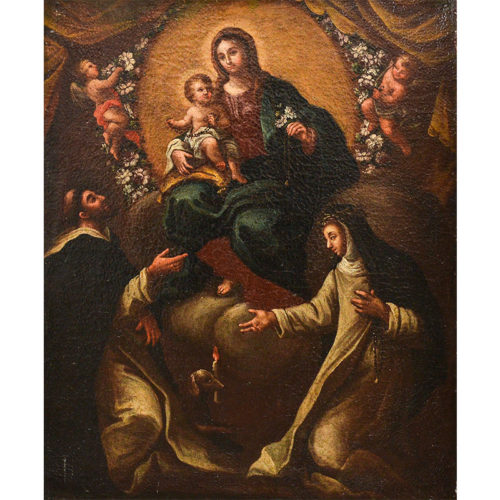-
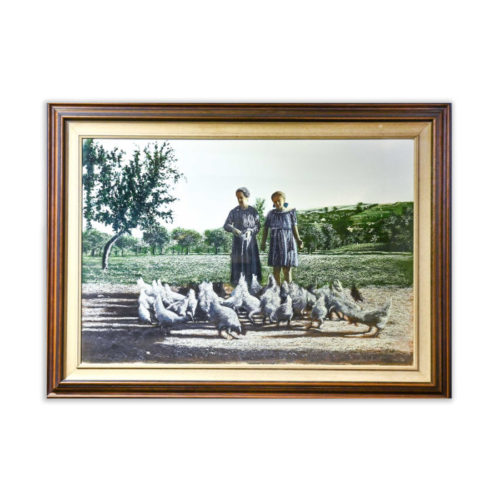 Scene of a courtyard, oil on cardboard by Daniele Fissore, signed and dated on lower right, a very rare work as the artist usually depicts the landscape without figures. Daniele Fissore (Savigliano 1947 - Savigliano 2017) began his artistic career as self-taught artist. In 1975 he took part in the X Quadriennale in Rome and in 1976 in the "Biennale del disegno" in Milan. A constant evolution of the first pictorial themes (see the "Telephone booths", the "Oppositions", the "Reconnaissance", investigated with an in-depth analysis of strong photographic inspiration), led him to the human figure and the portrait. Period: 1980 Measurements: Framed H 69 x W 93 x D 4,5 / Cardboard H 60 x W 84 cm
Scene of a courtyard, oil on cardboard by Daniele Fissore, signed and dated on lower right, a very rare work as the artist usually depicts the landscape without figures. Daniele Fissore (Savigliano 1947 - Savigliano 2017) began his artistic career as self-taught artist. In 1975 he took part in the X Quadriennale in Rome and in 1976 in the "Biennale del disegno" in Milan. A constant evolution of the first pictorial themes (see the "Telephone booths", the "Oppositions", the "Reconnaissance", investigated with an in-depth analysis of strong photographic inspiration), led him to the human figure and the portrait. Period: 1980 Measurements: Framed H 69 x W 93 x D 4,5 / Cardboard H 60 x W 84 cm -
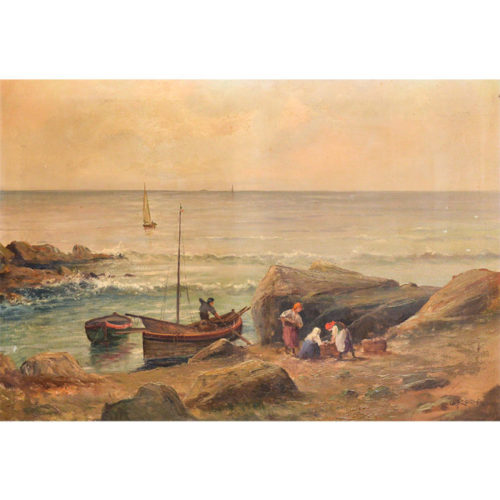 "Marine with boats and characters" - Oil on canvas by Leonardo Roda dating back to the early 1900s, signed on the lower right. RODA LEONARDO. Born in Racconigi in 1868, died in Turin in 1933. A pupil of Marco Calderini, he participated in various exhibitions in Turin and Milan. He was a faithful, tireless reproducer of the Matterhorn. «In the last decade his brush stroke got tired and he also suffered morally. Six months before he died he managed to deliver eighteen commission paintings for a Roman house of art: but it was his last effort » (Dragone). Some of his works: Raggio di sole; Nomadic life; Quiet corner, purchased by the Society for Fine Arts of Turin in 1914.Period: Early 1900s Measures: In frame H 79.5 x L 109.5 x P 5 / Canvas H 70 x L 105.5 cm
"Marine with boats and characters" - Oil on canvas by Leonardo Roda dating back to the early 1900s, signed on the lower right. RODA LEONARDO. Born in Racconigi in 1868, died in Turin in 1933. A pupil of Marco Calderini, he participated in various exhibitions in Turin and Milan. He was a faithful, tireless reproducer of the Matterhorn. «In the last decade his brush stroke got tired and he also suffered morally. Six months before he died he managed to deliver eighteen commission paintings for a Roman house of art: but it was his last effort » (Dragone). Some of his works: Raggio di sole; Nomadic life; Quiet corner, purchased by the Society for Fine Arts of Turin in 1914.Period: Early 1900s Measures: In frame H 79.5 x L 109.5 x P 5 / Canvas H 70 x L 105.5 cm -
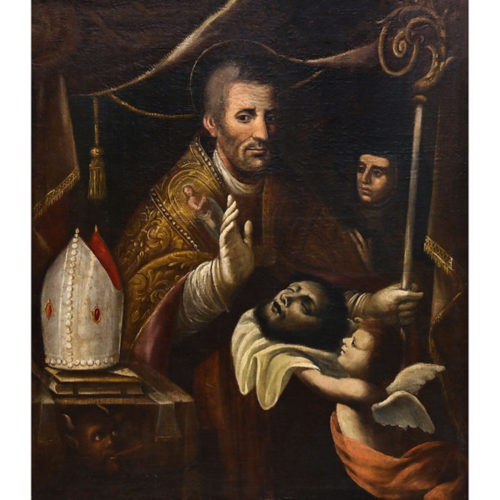 "San Grato Di Aosta with the head of the Baptist" oil on canvas from the first half of the 18th century. The work has been restored. An important legend flourished on the account of San Grato, now proven to be completely anachronistic, which goes by the name of Magna legenda Sancti Grati and is attributed to canon Jacques des Cours, who lived in the 13th century. The story of the discovery of the head of St. John the Baptist, a relic often associated with San Grato in popular iconography, dates back to this tradition. Beheaded by a whim of the beautiful Salome, the head of the Forerunner by order of King Herod Antipas was buried in a well separated from his body, for fear that he might miraculously rejoin it and John might rise again. Grato had a vision from the Lord, in which he was shown the secret location of the burial. He left Aosta in the company of his companion Giocondo, received the Pope's blessing in Rome and then embarked for the Holy Land. During the crossing, a great storm broke out, which threw terror among the sailors, but Grato, raised his arms to the sky, which instantly returned calm. When he arrived in Macheron, near the ruins of Herod's castle, an angel guided him, taking him by the hand and leading him to the well where the head of the Baptist had been for centuries. Immediately the relic rose to the surface and settled in Grato's outstretched palms. Period: First half of the 18th century Measurements: H 110.5 x W 97 x D 2 cm
"San Grato Di Aosta with the head of the Baptist" oil on canvas from the first half of the 18th century. The work has been restored. An important legend flourished on the account of San Grato, now proven to be completely anachronistic, which goes by the name of Magna legenda Sancti Grati and is attributed to canon Jacques des Cours, who lived in the 13th century. The story of the discovery of the head of St. John the Baptist, a relic often associated with San Grato in popular iconography, dates back to this tradition. Beheaded by a whim of the beautiful Salome, the head of the Forerunner by order of King Herod Antipas was buried in a well separated from his body, for fear that he might miraculously rejoin it and John might rise again. Grato had a vision from the Lord, in which he was shown the secret location of the burial. He left Aosta in the company of his companion Giocondo, received the Pope's blessing in Rome and then embarked for the Holy Land. During the crossing, a great storm broke out, which threw terror among the sailors, but Grato, raised his arms to the sky, which instantly returned calm. When he arrived in Macheron, near the ruins of Herod's castle, an angel guided him, taking him by the hand and leading him to the well where the head of the Baptist had been for centuries. Immediately the relic rose to the surface and settled in Grato's outstretched palms. Period: First half of the 18th century Measurements: H 110.5 x W 97 x D 2 cm -
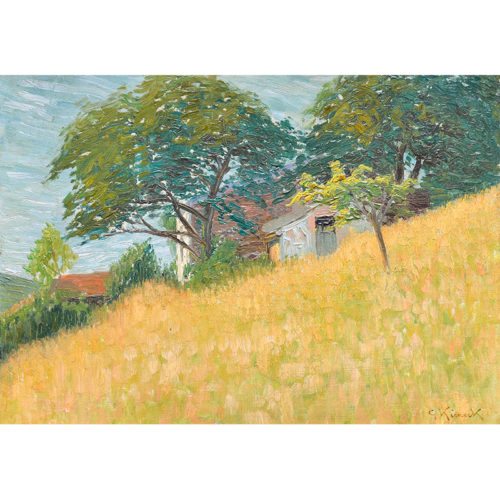 Period: 30s / 40s Measures: H 44 x L 55 x P 6 / Tablet H 26 x L 35 cm"Landscape" - Oil on tablet by Giorgio Kienerk (1869-1948). Signed on the lower right. The work was already sold in Martini auction in December 2011. KIENERK GIORGIO. He was born in Florence, in an ancient Tuscan family, on May 5, 1869. He studied with Adriano Cecioni, then, recommended by Telemaco Signorini, he dedicated himself not only to sculpture but also to painting. He formed, therefore, alongside Macchiaioli and made his debut very early, exhibiting six small landscapes at the Promotrice of Florence in 1888. He continued annually to present paintings and statues there. From 1891 to 1895 he followed the Divisionist school and painted, among other things, In riva all'Arno and Mattino sul mare. In 1897 he exhibited two large pastel female portraits at the Internationale of art and flowers in Florence and then oriented himself towards large figures, often with an allegorical meaning. In 1898 he appeared in Turin with Dolore. Then he participated in the Venetian Biennials with La vergognosa (1899), Il Silenza (1901), the Portrait of Irma Gramatica, pastel (1903), Sera, drawing (1905). He then came to the main Italian and foreign exhibitions in Brussels, Munich, Vienna, London, Saint Louis, Buenos Aires. With his scratched, borderless drawings, he has collaborated in magazines and newspapers (La Fiammetta, No-vissima, L'Italia ride, La Domenica dell'Avanti, La Liguria ligure, Numero, Gil Blas and Cocoricò dì Parigi). In 1905 he was appointed director of the civic painting school of Pavia. In the early period Pavia was particularly interested in sculpture, especially bronze plaques, a genre that he cultivated for a long time. After 1913, thanks to the experience acquired with the studies on Divisionism and mindful of the research of colors and light of the early years, he returned to deal with landscape and from then until his death the campaign was a continuous source of inspiration, especially after 1920 when he started working in Fauglia, on the Pisan hills (The washerwomen, Under the olive tree, In the shadow of the Carob tree, Dusty road). The portraits also belong to his last production (Portrait of the Marquis Quaratesi). In 1922 he exhibited in Florence at the Fiorentina Spring and until 1936 several times in Pavia. In 1936, finishing his teaching at the school of painting, many works were purchased by the Municipality of Pavia and are located in the museum of that city. From 1937 to 1943 he lived in Florence, exhibiting in various solo shows in Florence itself and also in Lucca and Livorno. In 1947 an exhibition of his works was opened at the Galleria Geri in Milan. Retiring to Fauglia with his family in 1943, he died in his villa in Poggio alla Farnia on February 15, 1948. His works can be found in the Modern Art Galleries of Venice, Florence, Lima (Peru) and in the Museum of Brussels. Many are in private collections in Pavia, Milan, where in the Turri Collection there is a Girl's Head, in Genoa, Florence. He engraved some drypoint plates.
Period: 30s / 40s Measures: H 44 x L 55 x P 6 / Tablet H 26 x L 35 cm"Landscape" - Oil on tablet by Giorgio Kienerk (1869-1948). Signed on the lower right. The work was already sold in Martini auction in December 2011. KIENERK GIORGIO. He was born in Florence, in an ancient Tuscan family, on May 5, 1869. He studied with Adriano Cecioni, then, recommended by Telemaco Signorini, he dedicated himself not only to sculpture but also to painting. He formed, therefore, alongside Macchiaioli and made his debut very early, exhibiting six small landscapes at the Promotrice of Florence in 1888. He continued annually to present paintings and statues there. From 1891 to 1895 he followed the Divisionist school and painted, among other things, In riva all'Arno and Mattino sul mare. In 1897 he exhibited two large pastel female portraits at the Internationale of art and flowers in Florence and then oriented himself towards large figures, often with an allegorical meaning. In 1898 he appeared in Turin with Dolore. Then he participated in the Venetian Biennials with La vergognosa (1899), Il Silenza (1901), the Portrait of Irma Gramatica, pastel (1903), Sera, drawing (1905). He then came to the main Italian and foreign exhibitions in Brussels, Munich, Vienna, London, Saint Louis, Buenos Aires. With his scratched, borderless drawings, he has collaborated in magazines and newspapers (La Fiammetta, No-vissima, L'Italia ride, La Domenica dell'Avanti, La Liguria ligure, Numero, Gil Blas and Cocoricò dì Parigi). In 1905 he was appointed director of the civic painting school of Pavia. In the early period Pavia was particularly interested in sculpture, especially bronze plaques, a genre that he cultivated for a long time. After 1913, thanks to the experience acquired with the studies on Divisionism and mindful of the research of colors and light of the early years, he returned to deal with landscape and from then until his death the campaign was a continuous source of inspiration, especially after 1920 when he started working in Fauglia, on the Pisan hills (The washerwomen, Under the olive tree, In the shadow of the Carob tree, Dusty road). The portraits also belong to his last production (Portrait of the Marquis Quaratesi). In 1922 he exhibited in Florence at the Fiorentina Spring and until 1936 several times in Pavia. In 1936, finishing his teaching at the school of painting, many works were purchased by the Municipality of Pavia and are located in the museum of that city. From 1937 to 1943 he lived in Florence, exhibiting in various solo shows in Florence itself and also in Lucca and Livorno. In 1947 an exhibition of his works was opened at the Galleria Geri in Milan. Retiring to Fauglia with his family in 1943, he died in his villa in Poggio alla Farnia on February 15, 1948. His works can be found in the Modern Art Galleries of Venice, Florence, Lima (Peru) and in the Museum of Brussels. Many are in private collections in Pavia, Milan, where in the Turri Collection there is a Girl's Head, in Genoa, Florence. He engraved some drypoint plates. -
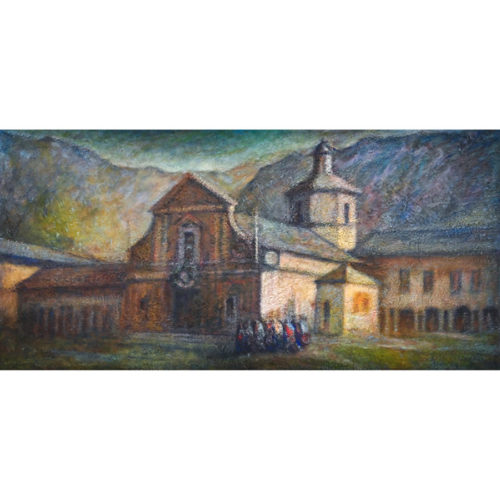 "Santuario d'Oropa" mixed media on canvas by Silvano Magliola Large painting, mixed technique on canvas, from the 1970s, depicting the Sanctuary of Oropa with its ancient Basilica. Silvano Magliola, painter from Biella in the second half of the 20th century. Period: 1970s Measurements: Framed H 114 x W 199,5 x D 4,5 cm / Canvas H 99 x W 184,5 cm
"Santuario d'Oropa" mixed media on canvas by Silvano Magliola Large painting, mixed technique on canvas, from the 1970s, depicting the Sanctuary of Oropa with its ancient Basilica. Silvano Magliola, painter from Biella in the second half of the 20th century. Period: 1970s Measurements: Framed H 114 x W 199,5 x D 4,5 cm / Canvas H 99 x W 184,5 cm -
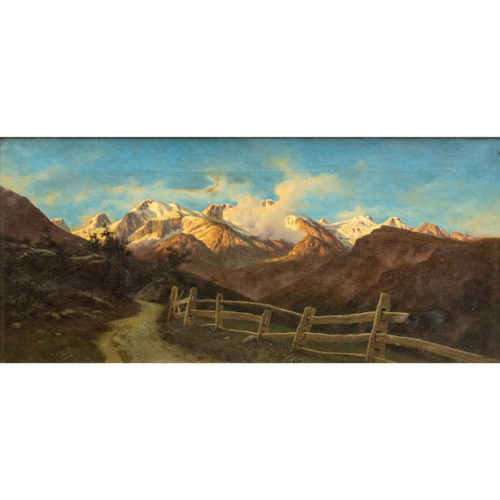 "Val d'Ayas" oil on canvas by Silvio Allason (1843-1912), signed and dated S.Allason 1909 lower left, in excellent condition. Silvio Allason (Turin 1845 - 1912), was first employed in the Ministry of War, but from around 1867 he devoted himself only to painting. After a stay in Florence, he was a pupil in Turin, at the Accademia Albertina, of E. Gamba and A. Gastaldi for the figure, studying however, at the same time, landscape with his cousin Ernesto and, upon his death, with E. Perotti . He began exhibiting at the Turin Promoter in 1869; in 1873 he had a notable success with the painting "In ambuato"; in 1876 he exhibited "The rescue". He made a specialty of the effects of moonshine with figures. He also exhibited in Milan, Naples, Paris (Salon of 1878), Nice, where one of his paintings "Among the rocks" was purchased for the Chéret Museum. Other works of his are in the Civic Museum of Turin. But an unknown title of Allison in landscape art is given by an infinity of studies from life, which he almost never showed, rich in superior elements, such as the wisdom and taste of composition, heroically patient drawing, simply effective technique and excellent color. Period: 1909 Measurements: In frame H 68 x W 128.5 x D 5.5 / Canvas H 52 x W 112.5 cm
"Val d'Ayas" oil on canvas by Silvio Allason (1843-1912), signed and dated S.Allason 1909 lower left, in excellent condition. Silvio Allason (Turin 1845 - 1912), was first employed in the Ministry of War, but from around 1867 he devoted himself only to painting. After a stay in Florence, he was a pupil in Turin, at the Accademia Albertina, of E. Gamba and A. Gastaldi for the figure, studying however, at the same time, landscape with his cousin Ernesto and, upon his death, with E. Perotti . He began exhibiting at the Turin Promoter in 1869; in 1873 he had a notable success with the painting "In ambuato"; in 1876 he exhibited "The rescue". He made a specialty of the effects of moonshine with figures. He also exhibited in Milan, Naples, Paris (Salon of 1878), Nice, where one of his paintings "Among the rocks" was purchased for the Chéret Museum. Other works of his are in the Civic Museum of Turin. But an unknown title of Allison in landscape art is given by an infinity of studies from life, which he almost never showed, rich in superior elements, such as the wisdom and taste of composition, heroically patient drawing, simply effective technique and excellent color. Period: 1909 Measurements: In frame H 68 x W 128.5 x D 5.5 / Canvas H 52 x W 112.5 cm
